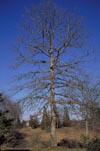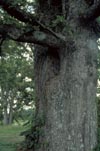Home >
Quercus stellata, Post Oak
Most often found on dry, low-fertility, sandy soils, Post Oak is extremely drought-tolerant making it well suited for dry unirrigated sites. Trees should be located in full sun. Native trees are very sensitive to soil compaction, drainage changes and soil disturbance. Unfortunately, the tree is usually not available in nurseries. Most people know the tree because housing and commercial developments are carved out of woods with existing plants. Trees are very sensitive to construction related injury which typically removes or covers part of the root system. Provide regular irrigation to trees with injured root systems.
Trees occur in north and central Florida south to Polk County.
Due to the coarse root system, the tree is often raised in fabric containers in field soil, is regularly root pruning in the field, or is grown in air root-pruning or copper root-pruning containers. The container systems allow for less circling roots along the edge of the root ball; the field systems may result in a greater portion of the root system harvested.
Co-national
champions are 85 x 88 feet in Virginia, 84 x 88 feet in Georgia, and 85
x 88 feet in Virginia.
Oak
wood is considered ring porous to semi-ring porous.





